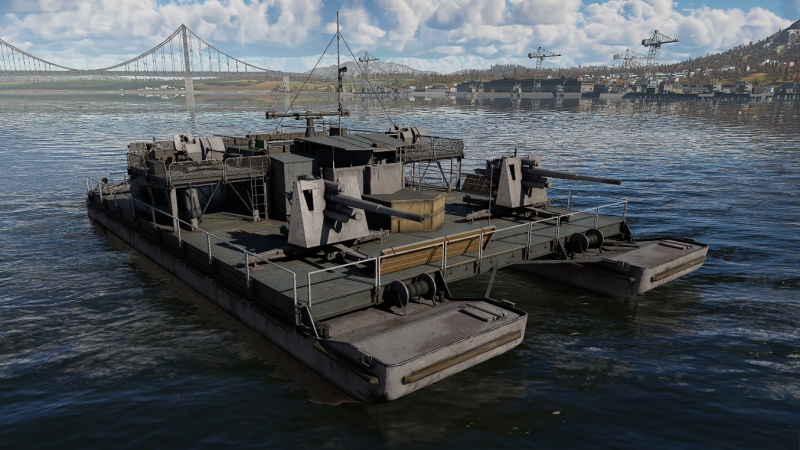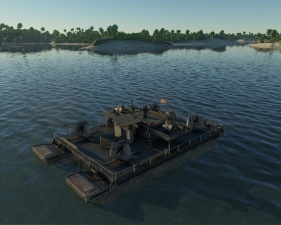SF40 Heavy
Contents
Description
The Siebelfähre 40 Heavy is a rank German anti-air ferry with a battle rating of (AB), (RB), and (SB). It was introduced in Update 1.79 "Project X" in the fleet closed beta test.
General info
Survivability and armour
The SF40 Heavy has the following armour layout:
- 2 cm/65 C/38 automatic cannon gunshields: 8 mm, hardened armour
- 8,8 cm Flak.36 cannon gunshield: 8 mm, antifragmentation armour
- Deckhouse: 10 mm, rolled homogeneous armour
- Hull: 8 mm, steel
- Superstructure: 20 mm, steel
The SF40 Heavy's armour is basically same as SF40 Leichte with changes around guns. It lacks armoured turret platforms so guns taken out with HE shells might occur more often. Besides armour, the SF40 Heavy can be a tough opponent to sink since most HE shots will hit the deck with no damage to the hull. Also, the rather high crew complement of 47 (5 more then Leichte) makes it harder to incapacitate by killing crew, though this is still the easiest way to take out this barge. Clever captains will try to angle the ship to allow aiming 3 guns on enemy targets, but this also makes the opposing ship able to hit only one of the four ammo storages. Even though this storage is high above the waterline, hitting it doesn't happen often since the bridge in the center is a way easier target to aim at.
Mobility
The SF40 Heavy's top speed is terrible. At 28 km/h (Arcade) / 22 km/h (Realistic) when fully upgraded, it might take several minutes for it to reach its destination. Always watch out for enemy PT boats and their torpedoes as they are the greatest threat to the SF40 Heavy's survival.
Modifications and economy
Armament
Primary armament
The 8.8 cm FlaK guns mounted on the SF40 Heavy have a good reload rate, accuracy and muzzle velocity thus making it easy to aim and control. The access to distance-fuse high-explosive shells and an elevation up to 85° degrees is very effective against big attackers and bombers flying high and slow. The reload rate also makes the SF40 a really dangerous opponent. However, these guns can be quite clunky against fast PT boats due to their relatively slow traverse speed.
Secondary armament
The 20 mm multi-purpose cannons with a fire rate of 480 rounds/min is very effective against small boats and lightly armoured ships as well as planes in close combat thus making the SF 40 also effective against light and fast naval and air targets.
Usage in battles
Because of its very slow speed, the SF40 Heavy will never be first to action in battle. Going full speed ahead, it can still take several minutes to reach the capture points on even small maps. How well the SF40 Heavy does in the battle depends not on how many enemies it can find, but rather how many enemies happen to run into it. To maximize this, the SF40 Heavy should be sailed towards the center of action on every map right from spawn, whether that be capture points or likely paths that enemy boats may take. Here, the SF40 Heavy can leverage its high survivability and overwhelm its opponents with firepower.
The 88 mm Flakvierling 36 cannons are an amazing main armament, able to destroy any coastal fleet vehicle with one or two hits. When using this vehicle, accuracy and patience are the two most important traits for survivability as evident by the slow top speed limiting the overall action. Many faster vessels with cannons can evade or quickly get behind cover, the SF40 Heavy is essentially a pinata for weapons like Bofors L/60 Mark 1 (40 mm) or large-calibre cannons (3-inch or larger). Boats armed with these can comfortably sit outside the SF40 Heavy's range and gradually chip away at the crew. This is even further accentuated when faced with destroyers, since they carry much larger guns and are generally unaffected by the SF40 Heavy's own 88 mm cannons (albeit you would still be able to kill their crew off by aiming at their superstructure).
The SF40 Heavy is best angled in such a way that three of four turrets are on target at once to maximize damage. At the same time, though, it should be angled as little as possible. This not only shows as little of the side and as possible, but it also allows the middle of the three Flakvierling 36's to block the line-of-sight to the deckhouse. Protecting the deckhouse is vital because it contains roughly half of the available crew. However, if it has already been destroyed, angling like this is no longer so important. The other major weakness is the ammo racks, which cannot be removed by taking less ammunition. Close-range enemies on the side are a big threat, since here, it is easiest to hit the ammo racks, especially when taking advantage of the hit cam. Though ammo rack destruction is quite rare in practice, a knowledgeable enemy player can still quickly eliminate the SF40 Heavy with this method. Aside from these points, survivability of the SF40 Heavy tends to be very high because of its size and large crew complement.
Enemy MTB torpedoes can be a threat, but only if launched at close-range, where the SF40 Heavy won't be able to evade in time. In this respect, long-range torpedo attacks aren't much of an issue, provided that they are spotted early enough. Even if torpedoes cannot be completely avoided, it should be noted that torpedoes can pass under the centre of the SF40 Light if necessary, between the two pontoons. Comparatively, greater threats are aerial torpedoes and rockets, guided bombs like Fritz X, and large bombs like H.C. 4,000 lb Mk.II (4,000 lb) or FAB-5000 (5,000 kg). Because of the SF40 Heavy's large size and slow movement, it makes for a prime target, while the SF40 Light's sluggishness may make evasion of these entirely impossible. Enemy aircraft should be prioritized.
Ammunition Choices
The primary ammunition choice of the 88mm Flakvierling 38 is the 8,8cm sprgr. L/4,5 Zt.Z times HE. This shell is commonly found on destroyers, but works spectacularly on this vehicle. The only difference stat-wise is the fuse which is set off when the shell reaches the target's range. This allows the shell to potentially explode over the target and cause some shrapnel damage or perhaps even shoot down aircraft in the hands of an experienced marksman. Be wary the lack of AP makes it difficult for the player to effectively counter destroyers.
For the 20 mm Flakvierling 38 guns, 20 mm HET magazines should be the primary ammunition choice, since it contains the highest ratio of HE to AP rounds and, thus, is the most effective against enemy boats and aircraft. The maximum range of the HE rounds is roughly 2.0 km, while the AP rounds can reach a little further to 2.3 km, though there isn't much point in using the 20 mm APT magazines for this purpose. Still, several 20 mm APT magazines should for the occasional armoued targets.
Enemies worth noting:
- Various destroyers (Leopard, USS Barker, Frunze): due to its BR, the SF40 Heavy will face early destroyers with high-caliber guns which can be very deadly. Furthermore, the SF40 Heavy will be occasionally pitted in a larger maps that will further worsen its range and speed disadvantage, especially in encounter/conquest mode where you will be pretty much useless as everyone can outrange you. However, in a smaller map in domination mode, the SF40 Heavy's range and speed problem is somewhat negligible as everyone is closer to each other and that the larger vessels have to navigate through shallow waters to capture the base and bring themselves into your effective range of fire.
Pros and cons
Pros:
- Powerful 88 mm guns can destroy a target with just 1 or 2 hits
- Can take quite a few hits
- Velocity and flat trajectory of shells makes it suitable to hang back and snipe enemies from >2 km
Cons:
- Not very fast or manoeuvrable
- Large target
- Lacks an AP shell for dealing with armoured targets.
- The 37 mm fast firing flak on the SF40 Leichte is replaced by two single 20 mm mounts
- Hard to get all 4 cannons on target
- Easy to torpedo or dive bomb due to its size and sluggishness
- Lacks a VT-fuze shell, only has timed and impact fuses
History
The Siebelfähre was designed by Friedrich Siebel, owner of a lesser-known German aircraft manufacturing company bearing his name. Siebel's idea was to provide the German army with a much needed easily mass-produced and effective transport vessel for the planned invasion of Britain.
His ferry would be a construction utilising parts of Bailey bridges and pontoons, which would make up the two barges connected in a catamaran style by a wooden deck. The vessel was supposed to be powered by aircraft engines and could easily be disassembled and reassembled thanks to its modular construction, allowing for the boat to also be transported by land.
The idea was met with great enthusiasm from the German military, and an order for 400 of this ferrycraft soon followed. The order encompassed more than just one version of the vessel, however. For instance, some versions were specialised to perform anti-air duties and were meant to cover the landing troops from air attacks. These were equipped with light 20mm and 37mm AA guns up to the heavy FlaK 88mm cannon, depending on the version.
However, before all 400 vessels could be made, the Invasion of Britain was cancelled, and thus the need for the Siebelfähre also disappeared below the waves. Nonetheless, around 200 of these vessels were still made before the order was cancelled and a majority of them found use in transport and mine-laying operations in the Black Sea and the Mediterranean. The Siebelfähre saw use right up to the end of the war, and some vessels continued serving well into the 1960s as civilian ferries.
- From Devblog
Media
- Skins
- Images
See also
External links
| Germany barges | |
|---|---|
| Anti-air ferries | SF40 Light · SF40 Heavy |
| Naval ferry barges | AF D1 · AF D3 |






